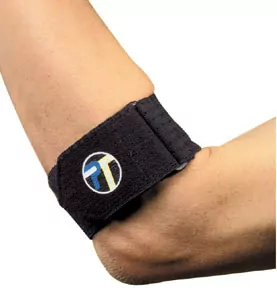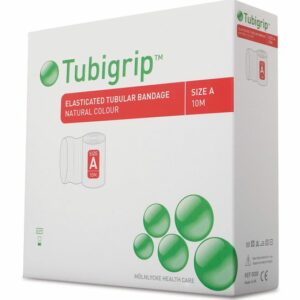Golfers Elbow (Medial Epicondylitis)
Updated:
(Also known as Golfers Elbow Syndrome, Medial Epicondylitis, Flexor Tendinopathy, Pronator Tendinopathy)
What is golfers elbow?
Golfers elbow is a relatively common injury which often occurs due to overuse and typically causes pain at the inner aspect of the elbow. It is a similar condition to tennis elbow however affects the inner aspect of the elbow rather than the outer aspect. It also has a significantly lower rate of incidence accounting for only 9 – 20% of all epicondylitis (i.e. golfer’s and tennis elbow) diagnoses.
The group of muscles at the front of the forearm are collectively known as the forearm flexors (figure 1). During contraction, these muscles flex the wrist and fingers (i.e. bend them forwards and make a fist) and have a common bony attachment at the inner aspect of the elbow called the medial epicondyle (figure 1). The forearm flexors attach to the medial epicondyle via their respective flexor tendons.
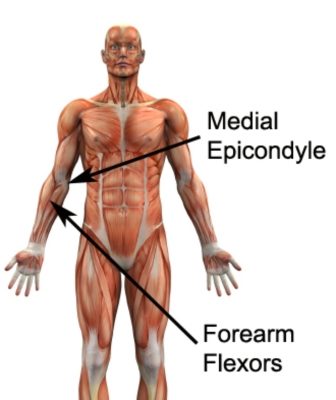
When the forearm flexors contract, tension is placed through the flexor tendons at their attachment to the medial epicondyle. When this tension is excessive due to too much repetitive, prolonged or high force, damage to one of the flexor tendons may occur.
Golfers elbow is a condition whereby there is damage (i.e. microtearing), with subsequent degeneration (and rarely inflammation) to one of the flexor tendons at its bony attachment to the inner elbow. This usually occurs due to gradual wear and tear associated with overuse, however, it may also occur in association with a specific traumatic incident.
Although this condition can occur at any age, it is commonly seen in patients between the ages of 40 and 60.
Causes of golfers elbow
Despite what the name suggests, you do not have to play golf (or any sport for that matter) to develop golfers elbow. In fact, 90 – 95% of cases do not involve sportsmen. Patients typically develop this condition due to activities involving repetitive, prolonged or forceful wrist flexion or gripping of the hand. These activities may include sports or manual work such as:
- golf (especially those who continually take divots out of the ground)
- tennis (especially those players who put a lot of top spin on the ball)
- squash
- badminton
- water skiing
- gymnastics
- body building or weight lifting
- carpentry
- plumbing
- hammering
- painting
- chopping wood
- bricklaying
- repetitive use of a screwdriver
- sewing
- knitting
- gardening
- cooking ( i.e. lifting heavy pots, stirring, cutting meat / vegetable)
- lifting or carrying activities
- working at a computer
It is also common for patients to develop this condition following a sudden increase in activities that place stress on the forearm flexors (such as involvement in a golf tournament over consecutive days) or due to a change in these activities (such as using a new technique or clubs, or hitting the ball too hard). In golf players, golfers elbow is often associated with poor swing technique.
Occasionally, golfers elbow may occur traumatically. This is usually due to a forceful movement involving a heavy lifting or gripping force through the arm. In golf, this may occur when mis-timing a shot and taking a divot out of hard ground.
A history of neck, shoulder, elbow or wrist injury may increase the likelihood of a patient developing this condition. Patients who smoke (or used to smoke) and those with type 2 diabetes may also have an increased likelihood of developing this condition.
Signs and symptoms of golfers elbow
Patients with golfers elbow, often develop symptoms gradually over a period of time. In the early stages of the condition, symptoms may present as an ache with rest (often at night or first thing in the morning) following a provocative or unaccustomed activity. Patients with this condition usually experience elbow pain located 1-2cm down from the bony lump on the inner aspect of the elbow (medial epicondyle – figure 1) that occasionally may radiate into the forearm. Pain or tenderness on firmly touching the medial epicondyle region (figure 1) is typically present.
In less severe cases of golfers elbow, patients may only experience a minor ache. In more severe cases, the pain can be debilitating and may prevent the patient from having a good night’s sleep. Most patients with this condition experience symptoms as an ache that increases to a sharper more intense pain with aggravating activity. Elbow stiffness may also be experienced and is often more prominent first thing in the morning. Occasionally, the presence of neck, shoulder or upper back pain on the same side of the body may be associated with the condition. In chronic cases prominent muscle weakness and reduced grip strength may also be evident.
Patients with this condition often experience an increase in symptoms during or after daily activities such as lifting things in the kitchen (such as the kettle, pots or pans), picking up a cup, weeding, opening a jar, turning a door handle, shaking hands, carrying groceries or turning the steering wheel of a car.
Diagnosis of golfers elbow
A thorough examination from a physiotherapist is usually sufficient to diagnose golfers elbow. Investigations such as an Ultrasound or MRI scan may be required, in rare cases, to confirm diagnosis and rule out a number of other conditions.
Treatment for golfers elbow

Members Only ContentBecome a PhysioAdvisor Member to gain full access to this exclusive content. For more details see Become a Member. Already a member? Login Now
Prognosis of golfers elbow
With appropriate management, most minor cases of golfers elbow that have not been present for long can usually recover within a few weeks. In more severe and chronic cases recovery can be a lengthy process and may take up to 6 months in those who have had their condition for a long period of time. Early physiotherapy intervention is therefore vital to hasten recovery.
Contributing factors to the development of golfers elbow
There are numerous factors which can increase the likelihood of a patent developing this condition. These should be assessed and corrected where possible by a physiotherapist. Some of these contributing factors include:
- excessive or inappropriate training or activity
- inadequate recovery periods from training or activity
- poor sporting equipment or technique
- muscle weakness or tightness
- poor posture
- joint tightness (especially the elbow, wrist, shoulder, upper back or neck)
- Medial collateral ligament instability
- inadequate warm-up
- a history of injury to the neck, shoulder, upper back or nerves that supply the elbow
- inadequate rehabilitation following a previous elbow injury
- a history of smoking
- having diabetes (Type 2)
Physiotherapy for golfers elbow

Members Only ContentBecome a PhysioAdvisor Member to gain full access to this exclusive content. For more details see Become a Member. Already a member? Login Now
Other intervention for golfers elbow
Despite appropriate conservative management, some patients with golfers elbow do not improve adequately. When this occurs the treating physiotherapist or doctor can advise on the best management plan. This may include further investigation (such as X-rays, ultrasound or MRI), pharmaceutical intervention, corticosteroid injection, autologous blood injection or referral to appropriate medical authorities (such as a sports doctor or orthopaedic specialist) who can advise on any intervention that may be indicated to improve the condition. In very rare chronic cases, surgical intervention may be considered.
Exercises for golfers elbow
The following exercises are commonly prescribed to patients with this condition. You should discuss the suitability of these exercises with your physiotherapist prior to beginning them. Generally, they should be performed 2 – 3 times daily (unless otherwise instructed) and only provided they do not cause or increase symptoms.
Your physiotherapist can advise when it is appropriate to begin the initial exercises and eventually progress to the intermediate, advanced and other exercises. As a general rule, addition of exercises or progression to more advanced exercises should take place provided there is no increase in symptoms
Initial Exercises for golfers elbow
Wrist and Finger Flexor Stretch
Keeping your elbow straight, take your wrist and fingers backwards using your other hand as far as you can go without pain and provided you feel no more than a mild to moderate stretch (figure 2). Hold for 2 – 5 seconds and repeat 5 – 10 times provided there is no increase in symptoms.
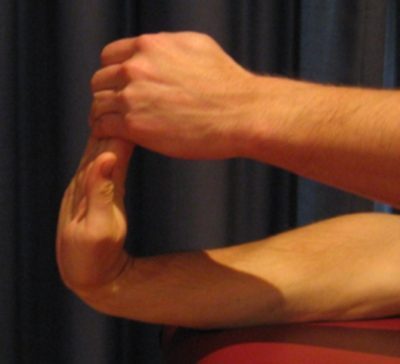
Chin Tucks
Begin sitting or standing tall with your back and neck straight, shoulders should be back slightly. Tuck your chin in as far as you can go without pain and provided you feel no more than a mild to moderate stretch (figure 3). Keep your eyes and nose facing forwards. Hold for 2 seconds and repeat 10 times provided there is no increase in symptoms.
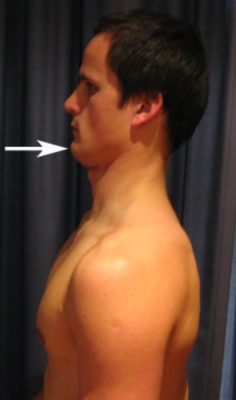
Shoulder Blade Squeezes
Begin this exercise by standing or sitting with your back straight. Your chin should be tucked in slightly and your shoulders should be back slightly. Slowly squeeze your shoulder blades together as far as you can go without pain and provided you feel no more than a mild to moderate stretch (figure 4). Hold for 5 seconds and repeat 10 times provided there is no increase in symptoms.
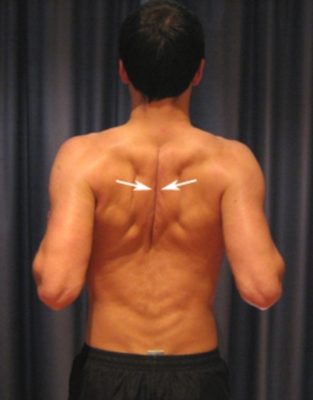
Intermediate Exercises for golfers elbow

Members Only ContentBecome a PhysioAdvisor Member to gain full access to this exclusive content. For more details see Become a Member. Already a member? Login Now
Advanced Exercises for golfers elbow

Members Only ContentBecome a PhysioAdvisor Member to gain full access to this exclusive content. For more details see Become a Member. Already a member? Login Now
Other Exercises

Members Only ContentBecome a PhysioAdvisor Member to gain full access to this exclusive content. For more details see Become a Member. Already a member? Login Now
Rehabilitation Protocol for golfers elbow

Members Only ContentBecome a PhysioAdvisor Member to gain full access to this exclusive content. For more details see Become a Member. Already a member? Login Now
 Physiotherapy products for golfers elbow
Physiotherapy products for golfers elbow
Some of the most commonly recommended products by physiotherapists to hasten recovery and speed healing in patients with this condition include:
To purchase physiotherapy products for this condition click on one of the above links or visit the PhysioAdvisor Shop.
 Find a Physiotherapist
Find a Physiotherapist
Find a physiotherapist in your local area who can assess and treat golfers elbow.
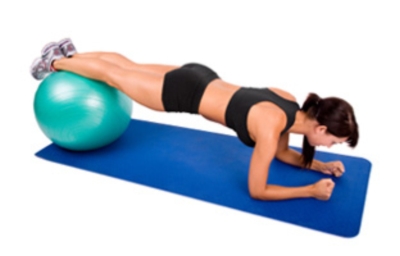 More Exercises
More Exercises
- Wrist Strengthening Exercises.
- Wrist Stretches.
- Elbow Strengthening Exercises.
- Elbow Stretches.
- Postural Exercises.
- Cable Exercises (Chest & Shoulders workout)
- Cable Exercises (Back & Biceps workout)
- Gym Exercises (Upper Body Machine Weights)
 Recommended reading for golfers elbow
Recommended reading for golfers elbow
- Golfers Elbow Taping.
- Ice or Heat.
- R.I.C.E. Regime.
- Mechanical Pain
- Inflammatory Pain
- Understanding Pain
- Why is my injury not improving
- Elbow & Forearm Diagnosis Guide.
Become a PhysioAdvisor Member
-
 Individual Membership (12 Months)$59.95 for 1 year
Individual Membership (12 Months)$59.95 for 1 year -
 Individual Membership (3 Months)$39.95 for 3 months
Individual Membership (3 Months)$39.95 for 3 months -
 Individual Membership (Yearly)$49.95 / year
Individual Membership (Yearly)$49.95 / year -
 Individual Membership (Monthly)$15.95 / month
Individual Membership (Monthly)$15.95 / month

Link to this Page
If you would like to link to this article on your website, simply copy the code below and add it to your page:
<a href="https://physioadvisor.com.au/injuries/elbow-forearm/golfers-elbow-medial-epicondylitis”>Golfers Elbow (Medial Epicondylitis) – PhysioAdvisor.com</a><br/>Golfers elbow is a relatively common injury which often occurs due to overuse and typically causes pain at the inner aspect of the elbow. Learn more about this at PhysioAdvisor.
Return to the top of Golfers Elbow (Medial Epicondylitis).

